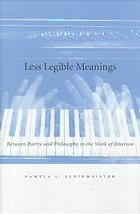
Less legible meanings : between poetry and philosophy in the work of Emerson PDF
Preview Less legible meanings : between poetry and philosophy in the work of Emerson
Less Legible Meanings Between Poetry and Philosophy in the Work ofEmerson Less Legible Meanings WW QQ Between Poetry and Philosophy in the Work of Emerson Pamela Schirmeister Stanford University Press Stanford,California Stanford University Press Stanford,California © by the Board ofTrustees ofthe Leland Stanford Junior University Printed in the United States ofAmerica data appear at the end ofthe book For Everett Seymour and Sara Acknowledgments One ofthis book’s main ideas is that community occurs at an inter- face we neither will nor choose.When we are most ourselves,we simply offer ourselvesand take one another up in ways we can nei- ther guarantee nor answer for.We are possibilities for each other, and in this potential exchange lies the essence of responsible com- munity.Writing is a pursuit that at every step implies community in this sense. What I have been unable to take up in this project will become clear in the following pages,and yet I have also benefited,some- times in the least expected of ways and from the least expected of places,from the community formed by making this book.I cannot promise that I have taken up the possibilities offered in the ways intended,but as Emerson has it,“The benefit overran the merit the first day and has overran the merit ever since.The merit itself,so- called,I reckon part ofthe receiving.”1 For me these benefits have been of many different sorts,and I ... vii viii ... Acknowledgments am grateful for all ofthem.Jacques Derrida’s seminars,across many years,taught me to ask the kinds ofquestions that ultimately shape the work here.I was particularly fortunate to have the opportunity to team teach with him in the fall ofon the subject ofhospital- ity;perhaps more than any other single factor,his remarks in that class made this book a different and far better one than it could oth- erwise have been. In a quite different way, Stanley Cavell’s work sparked the thoughts that enabled me to start on this book,and his continuing influence will be evident on every page.I can only hope that neither will object to the ways in which they have been taken for what Cavell would call “incentives for thinking.” Many of my colleagues offered untiring intellectual and per- sonal support as I wrote this book.I would like to thank Josephine Hendin,in particular,for providing both the time and the encour- agement that writing required,and also Kenneth Silverman,Denis Donoghue,John Maynard,Larry Lockridge,and Una Chaudhuri. Carolyn Dever very generously read parts ofthe manuscript,as did Edgar Dryden,and I thank them for their thoughtful commentary and patience.I have also been fortunate to know some extraordi- nary graduate students who helped me to think through the ideas that eventually showed up here.Sheila Boland,Peter Chapin,Eliza- beth Duquette,Tony McGowan,Anthony Reynolds,Shaindy Rud- off,and Deanna Turner all deserve thanks for the intellectual com- munity they created and for the privilege they offered ofseeing their own work unfold.Robert Gunn provided important bibliographical help.Helen Tartar,as always,has been the best editor anyone could hope for,and Kate Warne was of indispensable help as this book reached its final stages. Because a large amount of the thinking that gives contour to this book is psychoanalytic in nature,I also owe much of what I have written to colleagues well outside of my field.I have had the benefit and pleasure of working with them at various conferences, in study groups,and on graduate courses.Many of them have also been good friends.I am very thankful to Dr.Leonard Barkin,with whom I have cochaired a faculty colloquium on psychoanalysis and the humanities for a number ofyears,for many productive conver- sations and for making it worthwhile to go on trying to create a Reading Transference ... ix forum for genuinely interdisciplinary work;to Dr.Harvey Bezahler, for his help with the graduate course we team taught on the subject ofreading and transference;to Dr.Charles Goodstein,for giving me the opportunity to try out some of my ideas on his appropriately skeptical analysts-in-training; and to Dr. Adrienne Harris, with whom I team taught a course on identification and transference in literature and psychoanalysis,for all ofthe comments and ideas that helped me as I revised and expanded a first draft ofthis work.I am especially grateful for the help ofDr.Patricia Stevens without whom this book would have been neither started nor finished.Her contin- ued kindness and insight got me from one chapter to another and taught me much more than shows up in these pages. Some debts are harder to discharge than others.As always,my parents have believed in what I do and supported it in many differ- ent ways.To Everett Seymour and Sara go special thanks:to Everett, for patiently putting up with the worst ofme so that the best ofme could come out on these pages; and to Sara, for her remarkable sense of perspective,which has helped me to keep mine.No,Sara, you still cannot practice dancing on the computer keypad,but yes, the next book may well have pictures. P.S. Konstanz,Germany December
